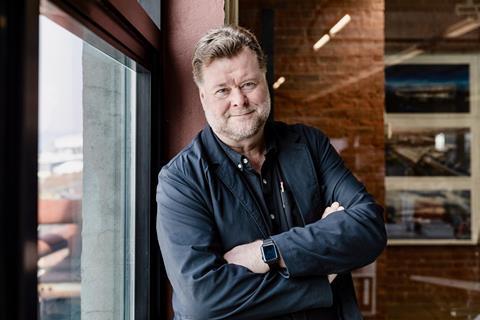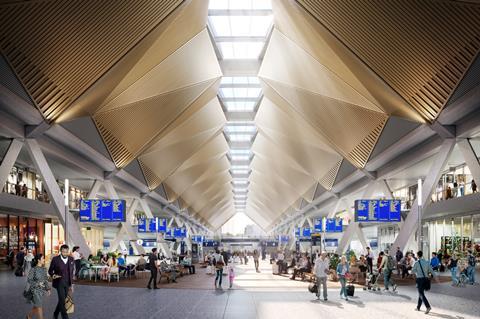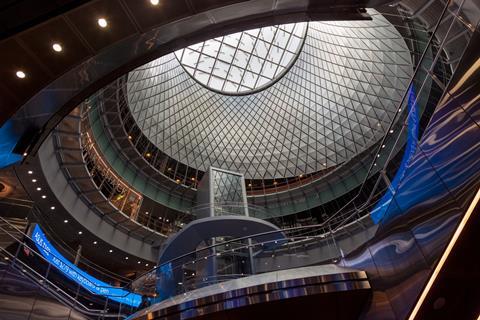The firm’s chairman Andrew Whalley says its three-year growth strategy “needed an edit” after the decision to mothball its biggest UK project, but the impact has not been as great as you might think. Tom Lowe reports.

It was in December last year that Mark Middleton touched down in drizzly London with a three-year strategy for Grimshaw in his suitcase. The architectural firm’s global managing partner had taken the 24-hour flight from his home in Sydney to present the plan to his fellow partners, which he did a few days later.
He had reasons to be confident. Grimshaw’s New York office was forced to lay off more than half of its staff during the pandemic, but its headcount was now back up to more than 120. The UK office, the firm’s largest, had also come through a rough patch after the government axed plans for a third runway at Heathrow. For the practice, a world leader in infrastructure, this had been a bitter blow.
But things were looking up. The strategy set out how the firm would plough through a feared global recession by focusing on low carbon schemes. At its core was an aim to grow smaller regional studios in LA, Dubai, Paris and Auckland to match the larger studios in London and New York. It also contained an ambitious diversity strategy for 30% of senior leaders to be women within three years.
Then came the plot twist that has become one of the biggest construction industry stories of the year. In March the government announced that it was mothballing HS2’s London terminus at Euston station amid spiralling costs.
It was Grimshaw’s biggest project in the UK, a £4.8bn behemoth which would bring the high speed line into the centre of the capital to connect it to the national rail and Tube networks. Now, following the decision to shelve it, the line will stop on the western outskirts of the city centre at Old Oak Common, meaning many of the savings on journey times which underpinned the business case for this £100bn railway will be lost.
Obviously it had an impact, but actually not as big of an impact as you might have thought
Losing such a big job was inevitably going to affect the business strategy. Although the plan crossed multiple national borders, bringing together all eight of Grimshaw’s studios, the size of Euston and the firm’s UK business meant the government’s decision affected the entire global practice.
“It definitely needed an edit,” admits the firm’s chairman Andrew Whalley. But the Grimshaw veteran, who joined the practice in 1986 and was appointed chairman in 2019, does not look like a man whose practice is going up in flames as he speaks to Building over Zoom from the New York office.
“We’re just amending it to adjust a couple of things. But it’s still working,” he shrugs.
“Obviously it had an impact, but actually not as big of an impact as you might have thought,” he says. “Because we have that kind of global spread and diversity, it’s always helped us weather challenges that are local to a particular economy, because it’s only ever part of the overall business.”

The London office had to put its entire workforce through collective consultations under the UK’s redundancy laws, but Whalley says the practice found new homes for many staff on other projects around the world. The ability to work remotely has made this relatively free of disruption, he says, as people have not had to be shipped off to different countries.
Many relocated staff have moved over to a series of major projects which the practice has just started in the Middle East, working mostly from London with a smaller team in New York.
Still, the firm had to move quickly. Grimshaw had been told just days before the decision to pause Euston was made public. While there had been worrying rumours coming out of Whitehall for a few months, the decision to pause the station came as a surprise.
In January, chancellor Jeremy Hunt had denied reports that the Department of Transport was looking at scaling back the central London stretch of HS2 to save money, insisting that he could not see “any conceivable circumstance” where the line did not reach Euston. When Whalley asked another minister in New York, he was told the station was “definitely happening. They’re not changing their mind” – a comment he blames on the “highly siloed” nature of government.
> Also read: MPs accuse government of ‘not knowing what it wants’ for HS2 Euston station
> Also read: Grimshaw profits double as global workloads increase
Whalley was on a Zoom call with some partners in London when he found out. “They had a break. And then they came back and told me: by the way, we’ve just heard [about Euston], so I stayed on rather longer than I thought.”
The partners had been told by Arup, to whom Grimshaw is subcontracted on the project, and from what was reported back it became evident that the delay was going to last for a significant period of time. The Department of Transport says it will last at least until next year, although transport secretary Mark Harper has admitted the station may not open until the line reaches Manchester, which is currently scheduled for 2035-40.
You dust yourself off and you get on with the next thing, and what else you have to do
It is the second time that Grimshaw has been burned by a government U-turn in recent years. After the £14bn Heathrow expansion was ruled unlawful in February 2020 due to the government’s climate commitments, and then mothballed despite the UK Supreme Court lifting the ban later that year, Grimshaw was forced to make at least 20 redundancies at its UK office.
“It’s a tough one for anyone,” says Whalley. “You commit a major emotional part of your life to architecture, to a project, and so you invest in it. We should do, because we’re all passionate about what we do.
“And then it stops. It’s like a bereavement to a degree and you’re going through all those different emotions, not believing it, and then you dust yourself off, and you get on with the next thing, and what else you have to do. Because as an architect, that’s what you have to do, because it’s the profession we’re in.”
It’s a trauma particularly familiar to architects working on large infrastructure projects, and also why Whalley seems so unfazed by the impact of the Euston delay. “It’s not unusual to have stops and starts and major infrastructure projects, I think we’ve had them on every major infrastructure project that I can think of,” he says.
He originally moved to New York in 2003 to oversee the Fulton Centre, a Grimshaw-designed transport and retail complex on Broadway in Lower Manhattan. First announced the previous year as part of a $7bn plan to rebuild the city’s transport infrastructure after the 9/11 attacks, it was intended to be fast-tracked but was soon beset by delays when funding dried up.
The scheme was still being revised in 2005, the year it was supposed to be completed, with construction not starting in earnest until 2009. Whalley had upped sticks with about four weeks’ notice, and expected to be there for a year. “Eleven years later, we were at the opening,” he says.

For Euston, he says the most serious impact is on Camden, specifically the Somers Town district around the station which is now set to be scarred for years by a 65,000sq m open site, where no progress is being made.
“For the people in Camden living around it, they were going to have to live through a construction period, they’re now living through a mothball period waiting for the construction to start again. They’re the ones that are going to lose now.”
The site’s design team, comprising Grimshaw, Arup and WSP, has gone from around 500 to just six. Andy Swift, the man in charge of building the station, has said his team is working on the assumption that construction will restart in 2025 once the government’s hiatus is lifted. But with so many staff redeployed to other projects, getting the team back together would be a headache even with this relatively brief delay.
We can’t criticise the government for not investing in infrastructure when we’ve got the largest infrastructure project in Europe running
“Another challenge is ensuring that, with these starts and stops, you also have a kind of continuity of knowledge to bring into it,” Whalley says. The practice is careful to maintain a level of experience and knowledge of the project, but there will still need to be a “ramping up period” when the project restarts.
So what is Whalley’s assessment of the government’s record on infrastructure investment during his career at Grimshaw? His answer, surprisingly, is that it’s “pretty good”.
“Obviously Euston for us is frustrating but the rest of HS2 is going ahead. There’s two tunnel boring machines busy working away. So the investment is still there and it’s the largest infrastructure project in Europe. So I suppose we can’t criticise the government for not investing in infrastructure when we’ve got the largest infrastructure project in Europe running.”

So what state is the three-year strategy in now? When Whalley took over as chairman from practice founder Nicholas Grimshaw in 2019 he gave a speech at the World Architecture Festival pledging that all of the firm’s projects would be designed to be net zero within a decade. That deadline is seen as the main driver of growth as clients and governments strive to reach their carbon reduction targets. This means turning down “a lot” of projects which are not seen as aligning with this strategy, Whalley says.
“We made the decision that we wanted work that has a kind of environmental, social, and sustainable impact. If someone phones up and asks us to do a series of seven-star luxury hotels, that’s not a project that really works for us. But, if it’s a design innovation centre that’s looking at new technologies like green hydrogen, that’s something we’d be really interested in helping support and make happen.”
The strategy aims to expand the firm’s business in the Middle East, not a part of the world which is most closely associated with net zero. But Whalley says there is an awareness of the importance of investing in the future, partly because the populations in the region are on average much younger than those in the US or the UK. “It has this sort of youthful outlook, or looking to the future,” he says.
Infrastructure, which currently accounts for around half of Grimshaw’s work, will also continue to play a central role. One growing sector is light rail, which is seen by developed countries as an important component of future transport networks. Every studio is working on major rail projects, including a link in Los Angeles between the city centre and LAX and the new Penn station in New York.
It’s ideas that count, not not where they come from, or who they are
Longer term, the strategy tackles the looming issue of succession. Whalley is part of the second generation of Grimshaw leaders, following the man whose name is on the door.
The practice and its 24 partners are now looking to the third generation, which means ensuring a steady flow of talented younger people are ready to step into the shoes of those moving up the ranks. “From a cultural perspective, we’ve always been a meritocracy,” Whalley says. “It’s ideas that count, not not where they come from, or who they are.”
One barrier to recruitment has now been lifted with Arb’s newly signed mutual recognition agreements with the US, Australia and New Zealand, which has been made possible by the UK’s departure from the EU. “There’s always some advantages that come out of everything,” says Whalley.
It is also particularly favourable for Grimshaw, which has studios in all three countries. “It’s a great opportunity,” he says. “It allows greater diversity in the profession and greater diversity for the built environment which can only be a good thing. Having freedom and access but for great talent to move and be more mobile is a positive thing.”
Despite all of the disruptions of the last few years, Grimshaw is clearly on the front foot. And, if all goes to plan, one of its new recruits may one day lead the practice, and might just even commute into London on a high-speed train to Euston.
Andrew Whalley’s education projects
FIDA
The Future’s Institute at Dollar Academy (FIDA) was launched in 2021 to provide a new form of teaching in Scotland, a part of the UK which has seen a widening attainment gap between rich and poor. Grimshaw has designed a permanent home for the institute, which aims to provide equitable access to education, close the attainment gap, address sustainability and find “compelling alternatives to traditional teaching”.
The institute’s open source curriculum is based on the United Nations’ 17 sustainability development goals, and a new diploma for sustainability is now being set up that can be recognised by universities.
Andrew Whalley says the project is very close to his heart. “The young people work in teams, they work collaboratively, it’s very much about making and being hands on, so if you’re learning about physics, you’re designing and creating a robot not just sitting there looking at some of the formulas on the blackboard.”
“As an architect, I think being able to do things that have awesome social change is really exciting.”
The Glasgow School of Art
Grimshaw is also working with the Glasgow School of Art to develop a series of academic courses and collaborative research practices in partnership. The courses, which are being developed in partnership with the Grimshaw-designed Eden Project, will take inspiration from nature to provide an investigative approach to architecture and fine art design.
Whalley studied at the Glasgow School of Art before joining Grimshaw, and describes the school’s Mackintosh Building, which was severely damaged by fire for the second time in 2018, as one of his favourite buildings. “I went round it just before the first reconstruction was finished. It was nearly done. And it was looking amazing,” he says. “It’s beyond a tragedy that it should have burned down and burned down so badly the second time.”
















No comments yet